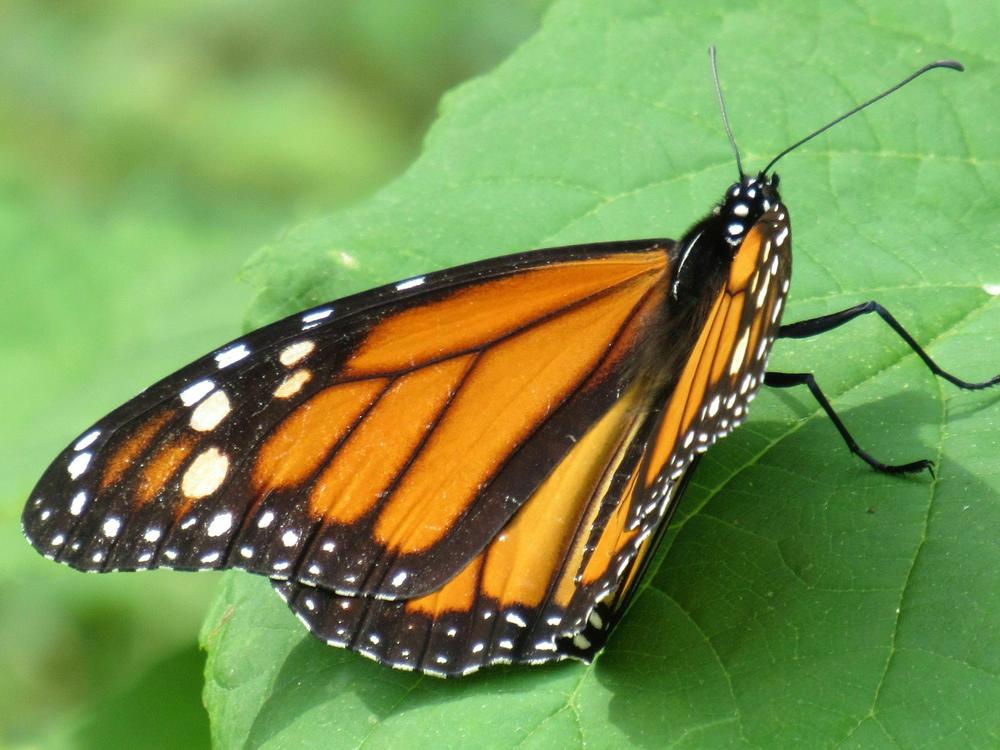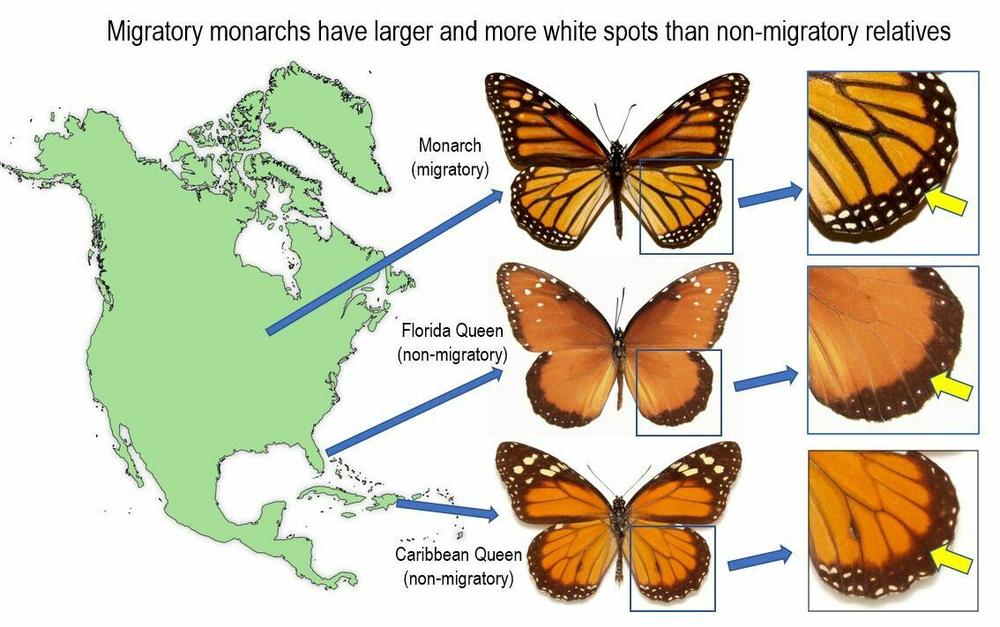Section Branding
Header Content
Monarch butterflies' white spots may help them fly farther, scientists say
Primary Content
Think of a monarch butterfly, and a distinctive image pops up: black-and-orange wings, with a sprinkling of white spots around the black edges. Those white spots may actually help monarchs complete their long-distance migration by altering the air flow around their wings.
Or, at least, that's the provocative new claim from a team of researchers that has analyzed hundreds of monarch wings collected along its migration route.
"If you have larger white spots, you're simply more successful at reaching Mexico," says Andy Davis, a researcher at the University of Georgia.
He and his colleagues believe that the pattern of color could interact with sunlight to create subtle temperature differences on the wing that can alter airflow, easing the butterflies' flight.
They're working on experiments that will test that by flapping real butterfly wings in a test chamber that will let them track the movement of air.
Other butterfly scientists have reacted to their work with both enthusiasm and skepticism.
"It, as far as I can tell, is a totally new idea. And I think it's quite exciting," says Marcus Kronforst, an evolutionary biologist at the University of Chicago who was not involved in this study.
"I've worked on butterfly color patterns my whole life, basically, and never, never considered this," says Kronforst. "It's never crossed my mind that it might influence how the butterflies fly."
One of the most famous migrations
Monarch butterflies definitely need to fly well to complete their annual fall migration of up to 3,000 miles.
"It's one of the most famous migrations of any insect in the world. Monarchs from as far north as Canada fly south every fall all the way to some mountain top sites in central Mexico," says Davis.
"One of the things that makes it so captivating as a scientist," he says, "is how something so small and so delicate-seeming can make such a tremendous journey."
In the spring, monarchs leave their over-wintering grounds and move north, laying eggs as they go. These summer monarchs live for only weeks, but successive generations of them move the species steadily northward until it is time for the autumn migration.
Then, one much-longer-lived generation of monarchs postpones breeding and resolutely heads south. "Those monarchs fly for about two months, flying all the way down there, or they die trying," says Davis.
Davis previously observed that monarch butterflies with darker, redder coloration seemed to fly better in lab studies. "We didn't really know why at the time," he says.
Most research on butterfly coloration focuses on its use for camouflage or as a warning to predators. Since monarchs eat milkweed that contains toxins, their bright orange color serves as a signal that they're unpalatable prey.
So his report linking a darker wing color to a better flying ability caught the attention of Mostafa Hassanalian, a biomechanics expert at the New Mexico Institute of Mining and Technology.
Hassanalian had studied the black-and-white patterns on migrating birds, and concluded that black coloration could affect temperature and airflow in ways that might improve their flight performance.
So the researchers teamed up and decided to look at the black and white coloration in the edge of monarch wings. Their group included Brenden Herkenhoff of New Mexico Tech, as well as Christina Vu and Paola Barriga at the University of Georgia.
They studied nearly 400 wild monarch wings from different locations along the migration path.
What they found is that the wings of the summer monarchs that aren't migrating have less white, while those that are migrating but haven't made it all the way to Mexico have more.
And monarchs that successfully reached Mexico have even more white, according to a report in the journal PLOS ONE.
The researchers also looked at white spots on closely related butterfly species that either don't migrate or only semi-migrate.
"We compared the monarchs versus all these other relatives," says Davis. "And sure enough, the monarchs had slightly larger spots than everybody else."
Meanwhile, other research has suggested that having more darkness on monarch wings in the spring might be an advantage for butterflies, by increasing heat absorption during cooler days, says Davis.
"It might be that there's sort of dueling selective pressures on the monarchs during the spring versus the fall," he says, with white dots being beneficial during the southward migrations and darker coloration being an advantage for generations that move northward.
Putting monarch wings to the test
Hassanalian says they're working on experiments that will attach monarch wings to a mechanism that flaps them. This will let them experiment with flapping different colored wings in a testing chamber that lets them visualize airflow around the wings.
"We have currently built the setup for birds' wings with a flapping mechanism, and we plan to make the same approach for butterflies," he told NPR in an email.
Without that kind of demonstration of a real effect on airflow, some researchers are skeptical.
"I'd be really interested in more aerodynamic measurements," says Mary Salcedo, a postdoctoral researcher at Cornell University who studies insect wings. "I'd love to see aerodynamic tests on their lift and drag coefficients."
After all, the white spots might have no effect, or be related to something else entirely.
Maybe the white spots somehow help monarchs evade bird predation, for example, and monarchs that migrate in the fall need this protection more because they live longer than summer monarchs and get exposed to more of this threat.
"I do think that this aerodynamic explanation is exciting. It's definitely different," says Kornforst. "I just think there are potentially some other explanations that could be explored."
Copyright 2023 NPR. To see more, visit https://www.npr.org.


